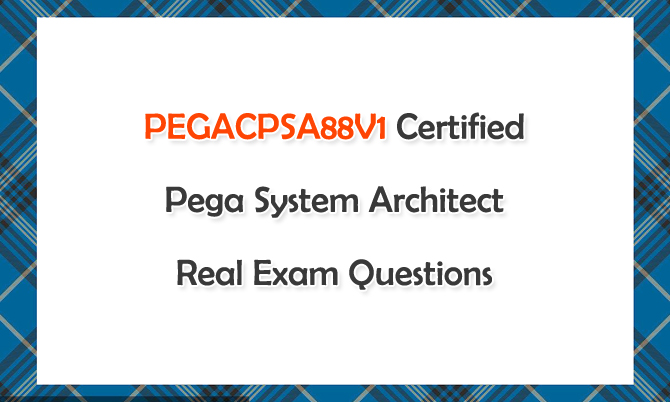PEGACPSA88V1 Certified Pega System Architect is designed for developers and technical staff members who want to learn how to develop Pega applications. This certification serves as the first level in the System Architect certification path and provides a foundational assessment of your knowledge of Pega applications. The PEGACPSA88V1 exam serves as a foundational certification for those looking to establish themselves as Pega System Architects. It provides a baseline measurement of knowledge in Pega application development and serves as a stepping stone for further certifications and advancements in the Pega System Architect career path.

CPSA Version 8.8 PEGACPSA88V1 Target Audience
The target audience for the PEGACPSA88V1 Certified Pega System Architect exam includes developers and technical staff members who are interested in learning how to develop Pega applications. This certification is designed for individuals who want to demonstrate their knowledge and skills in Pega application development. It is suitable for professionals who work with the Pega Platform and wish to validate their understanding of Pega application development concepts, best practices, and techniques.
Pegasystems Certification PEGACPSA88V1 Exam Info
Pegasystems Certification PEGACPSA88V1 exam information can help you understand the test well.
Number of questions: 60
Duration: 90 minutes
Passing Score: 65%
Available Language: English
PEGACPSA88V1 CPSA Version 8.8 Exam Topics
The PEGACPSA88V1 exam, Certified Pega System Architect version 8.8, covers the following topics.
1. Case Management (33%): Designing case lifecycles, configuring service level agreements, routing assignments, automating workflow decisions, and managing teams of users.
2. Data and Integration (23%): Configuring data types, relationships, and field types; validating and manipulating data; accessing external data sources; and saving data to a system of record.
3. Security (5%): Managing user and role assignments and configuring security policies.
4. DevOps (5%): Recording and executing unit tests, creating scenario-based test cases, and understanding best practices for unit tests.
5. User Experience (12%): Customizing user interface elements, forms, and controls; grouping fields in views; and enabling accessibility features.
6. Application Development (12%): Managing application development, scoping projects using the Estimator tool, creating and maintaining rules, and debugging errors.
7. Reporting (5%): Creating business reports, using columns and filters, and understanding the benefits of using Insights.
8. Mobility (5%): Configuring mobile app channels and utilizing Pega Mobile Preview.
Study Pegasystems PEGACPSA88V1 Real Exam Questions
The latest Pegasystems certification PEGACPSA88V1 real exam questions are the best guides for you to study the above Certified Pega System Architect topics. Share some PEGACPSA88V1 real exam questions and answers below.
1.All managers need to view the Employee vacation requests report in their Manager portal dashboards. Only managers have access to this report. Which configuration do you perform to fulfill these requirements? Available Choices (select all choices that are correct)
A. Create a new landing page on the Manager portal with the new report saved in a public category
B. Add a report widget to the Manager portal dashboard and then click Publish to default
C. Add a report widget to the Manager portal dashboard and then click Publish
D. Add the out-of-the-box Reports landing page to the Manager portal
Answer: C
2.To qualify for an instant loan an applicant must earn a monthly income of at least GBP2000 and cannot exceed GBP15000 in credit card debt. How do you enforce these restrictions when requesting an instant loan? Available Choices (select all choices that are correct)
A. Use a Validate rule to call two Edit validate rules one for income and one for credit card debt
B. Use Ul controls to validate the entries in the income and credit card debt fields
C. Use a single Validate rule with two conditions one for income and one for credit card debt
D. Use two Edit validate rules one for income and one for credit card debt.
Answer: C
3.You are configuring an external data source using the Integration Designer. You have the REST, Dev, Stage, and Prod endpoint URLs, and a name for the data source. What other information do you need to configure the external data source?
A. The data views using the external data source
B. A backup endpoint URL if the configured URL refuses to connect
C. The name of the database where the source data is stored
D. A plan for mapping the data and REST response fields
Answer: D
4.You want to unit test a rule to ensure that the rule executes as intended, you need to populate a test page with valid data Which two options allow you to populate a test page before testing the rule? (Choose two) Available Choices (select all choices that are correct)
A. Copy data from an existing clipboard page
B. Configure a validate rule to populate the page with the necessary data
C. Configure an assertion to define the required data
D. Run a data transform to create the test page.
Answer: A,D
5.A survey is sent to a customer via email. How do you configure a solution to ensure the email Includes the case ID for the survey? Available Choices (select all choices that are correct)
A. Call a data transform to copy the case ID from pyWorkPage to the email
B. Create a required field for the case ID that must be entered by a user during the case process prior to sending the email
C. Use the Insert Property feature of a Send Email step to add the case ID when composing the custom message
D. Create a process using the Send Email step allowing representatives to quickly add the case ID to the email
Answer: C
